“Life on Land” in Europe
 Adam MacRae
Adam MacRae  September 12, 2023
September 12, 2023  Adam MacRae
Adam MacRae  September 12, 2023
September 12, 2023 As of the publishing of this briefing, over 137,000 square kilometres have gone up in smoke in Canada, burning over 290 million tonnes of carbon locked in the trees. That 290 million tonnes of carbon equals to more than 1.06 billion tonnes of C02 emissions – to put that in perspective, Canada’s economy emits roughly 672 million tonnes of CO2 per year. All of this has taken place during a year with the hottest day ever recorded, the hottest June ever recorded, and the hottest July ever recorded.
As a planet, we are reaching a moment in time where the health and very existence of our forests are at a breaking point. It is under these dire circumstances that we turn our attention to cover the 15th Global Goal of “Life on Land” in Europe. Here, we focus specifically on the conservation and restoration of terrestrial and freshwater ecosystems measured by forest area as a proportion of the total land area.
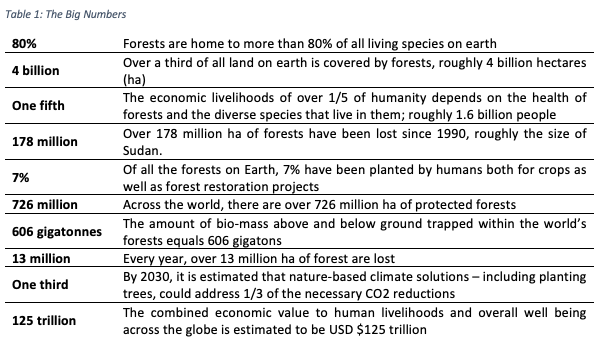
So, what exactly is a forest? It’s just a lot of trees clumped together, right? Well, not exactly. According to the United Nations Food and Agriculture Organization (FAO), a forest is defined as:
So, what does this mean? Basically, a patch of land with trees that are able to reach the necessary heights and are not man-made parks or plantations.
As illustrated in Chart 1, since 1990, the world has lost more than nearly 1.8 million square km of forest area (177,499,210 hectares), on average 50,000 square km per year. Another way of thinking of that is over 8 million football pitches of forests cut down every year, or 22,703 a day.
This steady and continuing decline is due to a combination of increased demand for forest products, expansion of agricultural land, and the growth of human development and housing needs.
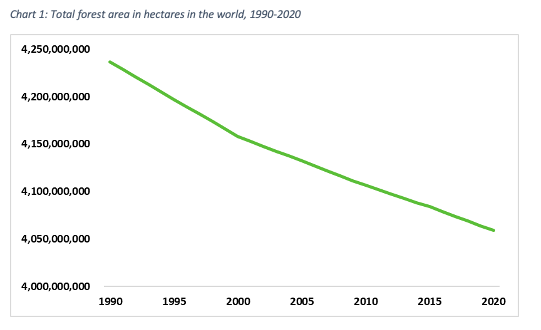
Technically, Europe tops the world rankings accounting for 25.07% of all forest area as illustrated in Chart 2, which is nothing to dismiss.
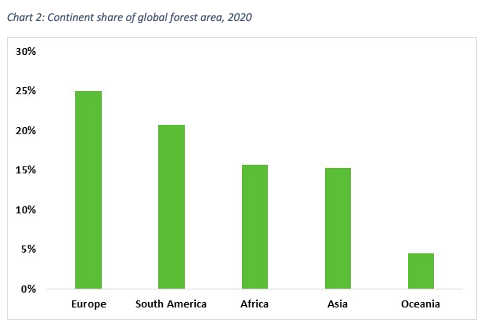
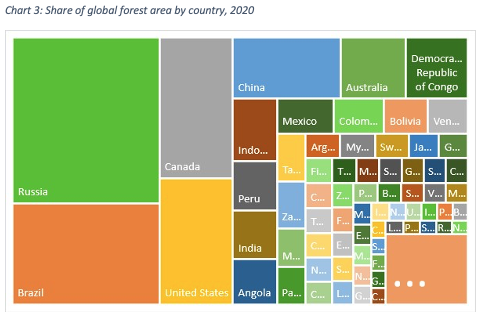
On this count, Europe also scores relatively well. After excluding a few micro-states, a number of European countries make it into the top spots including Finland and Sweden. Specifically in the European context, Chart 4 shows us both the absolute area of forest as well as the share of land occupied by forests on a country level by country ranking. As one would expect, Finland stands out in both respects, whereas others like Malta, is a laggard.
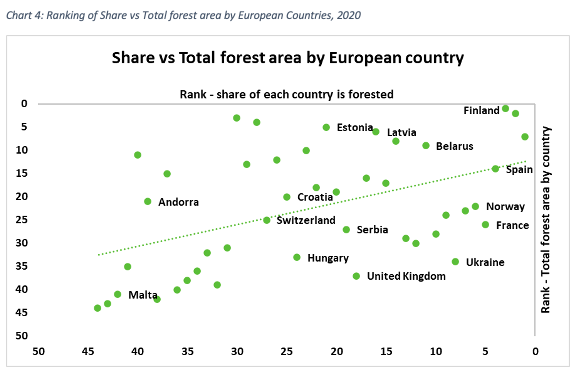
A final consideration concerns the policy ecosystem where the Brussels-effect strikes again. With regards to the proportion of forest area with long-term management plans in place, Europe comes out on top with 96%. The next best is Asia (64%), followed by North America (59%), Oceania (31%), Africa (24%), and South America (17%).
Europe may still have a long way to go to protect its forests, but it is a positive first step to know that nearly 100% of the forested area in the continent has long-term plans in place to protect and support them.
That said, there are some negative developments which need to be addressed. The first is that specifically within the EU, Eurostat’s monitoring report mentioned “slightly negative goal-level assessment” for Global Goal 15. The report further highlighted that over the last half decade, Europe’s ecosystems and the biodiversity they are home to remain under significant pressure from human activities.
Further, the most recent information was collected prior to Russia’s illegal war in Ukraine. A direct and unfortunate consequence of war is the destruction and loss of natural habitats – including forested land. In Ukraine, there has also been documented examples of ecocide: “the unlawful or wanton acts committed with knowledge that there is a substantial likelihood of severe and either widespread or long-term damage to the environment being caused by those acts”. According to preliminary estimates, the war has led to over USD $51 billion in environmental damages. Specifically for Ukraine’s forests, over 2.4 million hectares (24,000 square km) have been damaged.
So, what can be done to protect existing forest areas and increase their proportion of the total land area? Ultimately, it will come down to a combination of four things.
First, we must draw a line in the sand and protect the forests we already have. We cannot afford to continue cutting down our forests at the current rate. There are serious ramifications that could result from continued deforestation including desertification of ecosystems.
Second, we have to start using land more efficiently. Ultimately, this comes down to prioritising building our communities up, not out. Instead of sprawl, it will require more condos and multi-family buildings instead of wasteful (from a land perspective) detached single family homes.
Third, we need clear policies to protect our existing forests as well as the strong enforcement of such policies. Without a combination of the two, people will continue to illegally log or damage existing forests if they believe there are no consequences to deter them.
Fourth, we must start planting more trees to make up for those that have already been cut down. It will require millions, if not billions of dollars of investment.
If you would like to learn more about how Holocene can support your business, get in touch with our Chief Sustainability Officer Adam at info@holoceneic.com.